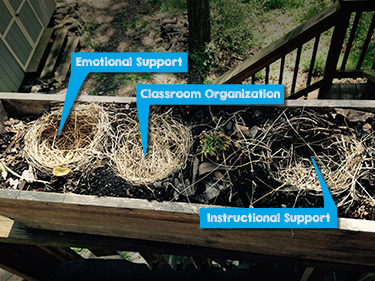

It’s a gorgeous spring day here in central Virginia. The trees are leafing out, the lilacs are in full bloom, and the birds are busy nesting. A particularly ambitious robin is building three nests in one of my planters. One is quite full, the other less so, and the third just has the beginnings of a proper nest. Looking at it reminds me of scoring trends for the three domains of the CLASS (generally, we see lots of evidence of effective Emotional Support and Classroom Organization, and less for Instructional Support). As coaches, what do we do about that, especially if we believe in a strengths-based approach?
Look for any evidence of Instructional Support
One key to helping teachers improve is to start with their strengths. But what does that mean if we see little evidence of Quality of Feedback? It means we scour our observation notes for anything that demonstrates QF. Did the teacher provide general praise (“good job” “nice work”)? Then recognize and label her efforts as recognition and affirmation—and talk about the impact of this praise on children. How did they respond? She might then be ready to explore more effective ways to encourage children’s efforts—but she might also need to sit with her current way of praising children, paying closer attention to it, before she’s ready to move into deeper ways to provide recognition and reinforcement.
Avoid talking about what could have been
It’s so easy as observers to see many ways to improve a lesson, to think “if only she’d asked a follow-up question” or “those children are so eager to explore, why didn’t she build on their engagement”? But processing with a teacher what she could have done results in a lowered sense of self-efficacy. Instead, try focusing on strengths to reinforce positive interactions and motivate teachers to repeat these types of behaviors. It’s critical to their growth.
Encourage teachers to reflect and expand on what they’re doing well
I have a tendency to say things like, “You were all smiles when you talked with Jediah, but when you met with the whole group, your affect was flat.” Sharing these types of observations (a positive observation followed by a “but”) is not helpful to most teachers. Better to say, “When you were talking with Jediah about his tower, you smiled and laughed with him. How did he respond? What was different when you met with the whole group?” That helps the teacher deeply engage in the process of examining her practice, which in turn helps her own the improvement process.
Back to the robin
So if I were to engage Mr. Robin in some strengths-based coaching, I’d point out that all three nests show signs of progress. I might ask him about the differences between the three. Despite my great curiosity, I’d refrain from asking about his family plans. I suppose I’ll just have to wait to see how many “wives” he’s able to attract (and that might inform his nest-building, too)!

